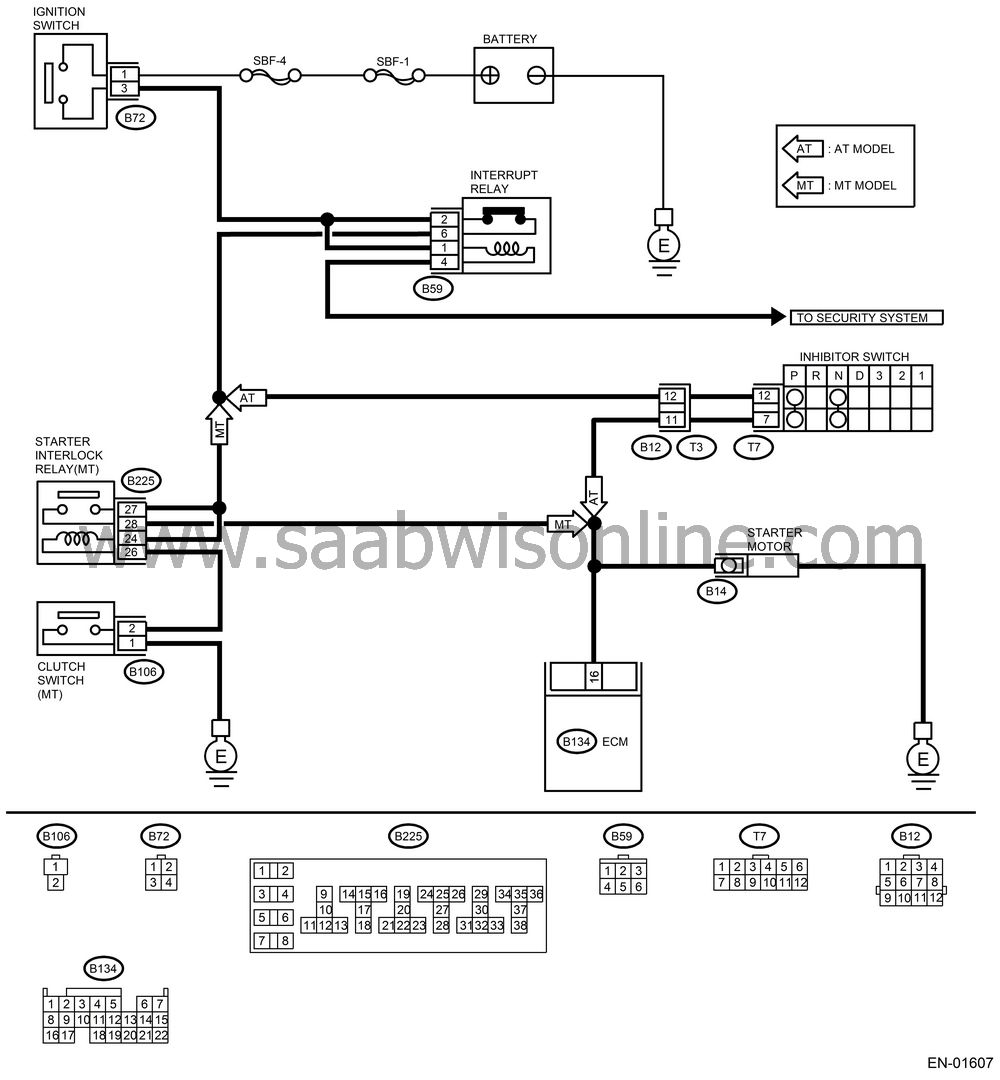STARTER MOTOR CIRCUIT
| STARTER MOTOR CIRCUIT |
| Important | ||
|
After repair
or replacement of faulty parts, conduct Clear Memory Mode
|
||
WIRING DIAGRAM:

CHECK OPERATION OF STARTER MOTOR.
Does the starter motor operate?
| Yes |
| No |
CHECK DTC.
Is the DTC displayed?

| Yes |
Using the List of Diagnostic Trouble
Code (DTC), check the appropriate DTC.

| No |
Repair the poor contact in ECM connector.
CHECK INPUT SIGNAL FOR STARTER MOTOR.
Turn the ignition switch to OFF.Disconnect the connector from starter motor.
Turn the ignition switch to START.
Measure the power supply voltage between starter motor connector terminal and engine ground.
Connector & terminal
(B14) No. 1 (+) — Engine ground (−):
| Note | ||
| • |
On AT model, move the select lever to “P” or “N” range.
|
|
| • |
On MT model, depress the clutch pedal.
|
|
Is the voltage more than 10 V?
| Yes |
| No |
CHECK GROUND CIRCUIT OF STARTER MOTOR.
Turn the ignition switch to OFF.Disconnect the terminal from starter motor.
Measure the resistance of ground cable between ground cable terminal and engine ground.
Is the resistance less than 5 Ω?
| Yes |
| No |
Repair the open circuit of ground cable.
CHECK HARNESS BETWEEN BATTERY AND IGNITION SWITCH CONNECTOR.
Disconnect the connector from ignition switch.Measure the power supply voltage between ignition switch connector and chassis ground.
Connector & terminal
(B72) No. 1 (+) — Chassis ground (−):
Is the voltage more than 10 V?
| Yes |
| No |
| • |
Check the following, repair
if necessary.
|
|
| • |
Blown
out fuse
|
| • |
Open circuit in harness between ignition switch and battery
|
CHECK IGNITION SWITCH.
Disconnect the connector from ignition switch.Measure the resistance between ignition switch terminals while turning ignition switch to START.
Terminals
No. 1 — No. 3:
Is the resistance less than 5 Ω?
| Yes |
| No |
Replace the ignition switch.
CHECK TRANSMISSION TYPE.
Is the transmission AT?
| Yes |
| No |
CHECK INPUT VOLTAGE OF INHIBITOR SWITCH.
Turn ignition switch to OFF.Disconnect the connector from inhibitor switch.
Connect the connector to ignition switch.
Measure the input voltage between inhibitor switch connector terminal and engine ground while turning ignition switch to START.
Connector & terminal
(B12) No. 12 (+) — Engine ground (−):
Is the voltage more than 10 V?
| Yes |
| No |
| • |
Repair open or short circuit
to ground in harness between inhibitor switch and ignition switch.
|
|
| • |
|
|||||||
CHECK INHIBITOR SWITCH.
Move the selector lever to “P” or “N” range.Measure the resistance between inhibitor switch terminals.
Connector & terminal
(T3) No. 11 — No. 12:
Is the resistance less than 1 Ω?
| Yes |
Repair open or short circuit to ground in harness between inhibitor switch and starter motor.
| No |
CHECK INPUT VOLTAGE OF STARTER INTERLOCK RELAY.
Turn ignition switch to OFF.Disconnect the connector from starter interlock relay.
Connect the connector to ignition switch.
Measure the input voltage between starter interlock relay connector and chassis ground while turning ignition switch to START.
Connector & terminal
(B104) No. 27 (+) — Chassis ground (−):
(B104) No. 24 (+) — Chassis ground (−):
Is the voltage more than 10 V?
| Yes |
| No |
| • |
Repair open or short circuit
to ground in harness between starter interlock relay and ignition
switch.
|
|
| • |
|
|||||||
CHECK STARTER INTERLOCK RELAY.
Connect the battery to starter interlock relay terminals No. 26 and No. 24.Measure the resistance between starter interlock relay terminals.
Terminals
No. 27 — No. 28:
Is the resistance less than 1 Ω?
| Yes |
| No |
Replace the starter interlock relay.
CHECK GROUND CIRCUIT OF CLUTCH SWITCH.
Disconnect the connector from clutch switch.Measure the resistance between clutch switch connector and chassis ground.
Connector & terminal
(B106) No. 1 — Chassis ground:
Is the resistance less than 5 Ω?
| Yes |
| No |
Repair open circuit of ground cable.
CHECK CLUTCH SWITCH.
Measure the resistance between clutch switch terminals while depressing the clutch pedal.Terminals
No. 1 — No. 2:
Is the resistance less than 1 Ω?
| Yes |
| No |
CHECK CLUTCH SWITCH CIRCUIT.
Connect the connector to clutch switch.Measure the resistance between starter interlock relay connector and chassis ground while depressing the clutch pedal.
Connector & terminal
(B104) No. 26 — Chassis ground:
Is the resistance less than 1 Ω?
| Yes |
Repair short circuit to ground in harness between starter interlock relay and starter motor.
| No |
Repair open circuit in harness between starter interlock relay and clutch switch.


